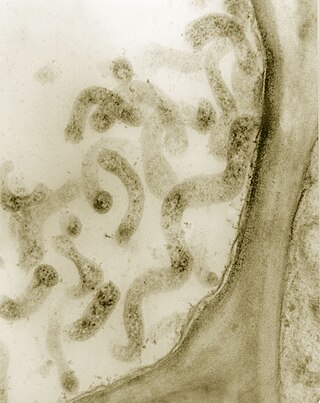Related Research Articles
The Thermoprotei is a class of the Thermoproteota.

The Leptospiraceae are a family of spirochete bacteria. It includes the genus Leptospira which contains some pathogenic species.

Entomoplasmatales is a small order of mollicute bacteria.
The bacterial order Chlamydiales includes only obligately intracellular bacteria that have a chlamydia-like developmental cycle of replication and at least 80% 16S rRNA or 23S rRNA gene sequence identity with other members of Chlamydiales. Chlamydiales live in animals, insects, and protozoa.
Atopobium is a genus of Actinomycetota, in the family Coriobacteriaceae. Atopobium species are anaerobic, Gram-positive rod-shaped or elliptical bacteria found as single elements or in pairs or short chains.
Rubrobacter is a genus of Actinomycetota. It is radiotolerant and may rival Deinococcus radiodurans in this regard.
Parachlamydiaceae is a family of bacteria in the order Chlamydiales. Species in this family have a Chlamydia–like cycle of replication and their ribosomal RNA genes are 80–90% identical to ribosomal genes in the Chlamydiaceae. The Parachlamydiaceae naturally infect amoebae and can be grown in cultured Vero cells. The Parachlamydiaceae are not recognized by monoclonal antibodies that detect Chlamydiaceae lipopolysaccharide.
Lentisphaerota is a phylum of bacteria closely related to Chlamydiota and Verrucomicrobiota.
Adlercreutzia is a genus in the phylum Actinomycetota (Bacteria).
Sporichthya is a genus of bacteria in the family Sporichthyaceae.
The Cryptosporangiaceae are the only family of the order Cryptosporangiales, which is a part of the phylum Actinomycetota.

The Thermoanaerobacteraceae is a highly polyphyletic family of bacteria placed within the class clostridia. Originally placed within the highly polyphyletic class Clostridia and order Thermoanaerobacterales, according to the NCBI and LPSN, it is now thought to be a basal clade of the phylum Bacillota.
Rarobacteraceae is a monotypic Actinomycetota family.
Ruaniaceae is an Actinomycete family with two monotypic genera.
Beutenbergiaceae is an Actinomycete family.
Bogoriellaceae is an Actinomycete family.
The Selenomonadales are an order of bacteria within the class Negativicutes; unlike most other members of Bacillota, they are Gram-negative. The phylogeny of this order was initially determined by 16S rRNA comparisons. More recently, molecular markers in the form of conserved signature indels (CSIs) have been found specific for all Selenomonadales species. On the basis of these markers, the Selenomonadales are inclusive of two distinct families, and are no longer the sole order within the Negativicutes. Several CSIs have also been found specific for both families, Sporomusaceae and Selenomonadceae. Samples of bacterial strains within this order have been isolated from the root canals of healthy human teeth.
Moorella is a genus of bacteria belonging to the phylum Bacillota.
Thermomonosporaceae is a family of bacteria that share similar genotypic and phenotypic characteristics. The family Thermomonosporaceae includes aerobic, Gram-positive, non-acid-fast, chemo-organotrophic Actinomycetota. They produce a branched substrate mycelium bearing aerial hyphae that undergo differentiation into single or short chains of arthrospores. All species of Thermomonosporaceae share the same cell wall type, a similar menaquinone profile in which MK-9(H6)is predominant, and fatty acid profile type 3a. The presence of the diagnostic sugar madurose is variable, but can be found in most species of this family. The polar lipid profiles are characterized as phospholipid type PI for most species of Thermomonospora, Actinomadura and Spirillospora. The members of Actinocorallia are characterized by phospholipid type PII.
The Genome Taxonomy Database (GTDB) is an online database that maintains information on a proposed nomenclature of prokaryotes, following a phylogenomic approach based on a set of conserved single-copy proteins. In addition to resolving paraphyletic groups, this method also reassigns taxonomic ranks algorithmically, updating names in both cases. Information for archaea was added in 2020, along with a species classification based on average nucleotide identity. Each update incorporates new genomes as well as automated and manual curation of the taxonomy.
References
- ↑ Pavan, María Elisa; Pavan, Esteban E.; Glaeser, Stefanie P.; Etchebehere, Claudia; Kämpfer, Peter; Pettinari, María Julia; López, Nancy I. (2018). "Proposal for a new classification of a deep branching bacterial phylogenetic lineage: transfer of Coprothermobacter proteolyticus and Coprothermobacter platensis to Coprothermobacteraceae fam. nov., within Coprothermobacterales ord. nov., Coprothermobacteria classis nov. and Coprothermobacterota phyl. nov. and emended description of the family Thermodesulfobiaceae". International Journal of Systematic and Evolutionary Microbiology. 68 (5): 1627–1632. doi: 10.1099/ijsem.0.002720 . hdl: 11336/93872 . PMID 29595416.
- ↑ Sayers; et al. "Thermodesulfobiaceae". National Center for Biotechnology Information (NCBI) taxonomy database. Retrieved 2019-01-07.
- ↑ J.P. Euzéby. "Thermodesulfobiaceae". List of Prokaryotic names with Standing in Nomenclature (LPSN). Archived from the original on 2013-01-27. Retrieved 2011-11-17.
- ↑ All-Species Living Tree Project. "16S rRNA-based LTP release 111 (full tree)" (PDF). Silva Comprehensive Ribosomal RNA Database . Retrieved 2013-03-20.